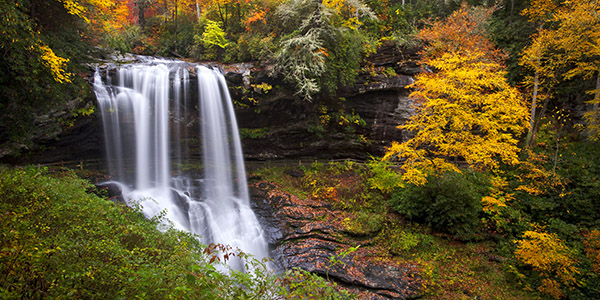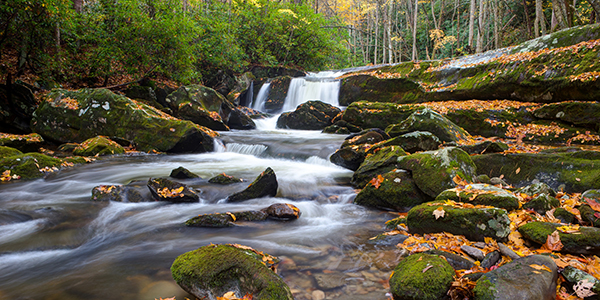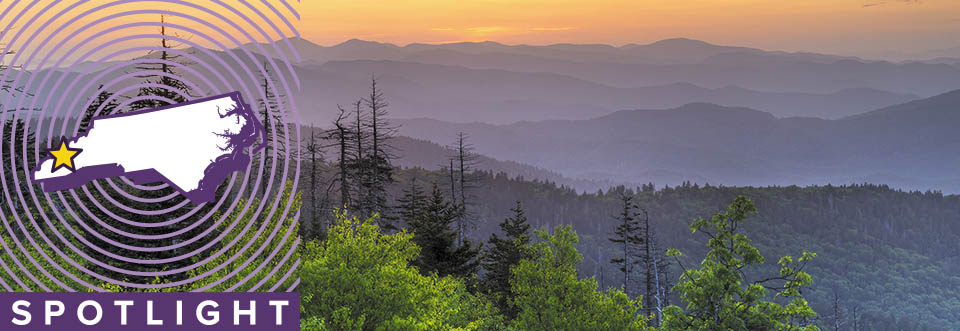The Great Smoky Mountains of North Carolina
Beat the crowds on the Tar Heel State side of the Smokies
Great Smoky Mountains National Park is the most-visited park in the nation (more than 10 million visitors each year), and no wonder. A national treasure of epic landscapes, diverse outdoor adventure and riveting history, the park extends for more than 800 square miles in both North Carolina (276,000 acres) and Tennessee (244,000 acres). Appalachian Mountains history finds expression in over 100 structures ranging from churches, homes and schools to barns and grist mills.
The NC Side
North Carolina’s Smoky Mountains receive much less visitor traffic than their Tennessee counterpart, and chances are you can find solitude and glorious panoramas without the selfie stick-wielding crowds. Besides superb hiking (850 miles of hiking trails, including the mother of all trails: the Appalachian), the park is an outdoor enthusiast’s dream with excellent fly fishing, biking, horseback riding, rafting, kayaking and canoeing.

Getty Images/iStockphoto
The main North Carolina entrance is just outside the town of Cherokee on U.S. 441 North, at the Oconaluftee Visitor Center. One of the Smokies’ finest moderate hikes, the Andrews Bald Trail meanders through spruce-fir forest while the less challenging Big Creek Trail offers a scenic hike through woodlands ablaze with wildflowers and stirring views of Mouse Creek Falls.
The park’s incredibly diverse landscapes — including majestic forests, some of the tallest peaks in the United States and bucolic meadows carpeted with wildflowers — will take your breath away. The views defy hyperbole, especially from the 6,643-foot Clingmans Dome, the third-highest mountain peak east of the Mississippi. At the summit, a half-mile paved trail leads to an observation tower offering a 360-degree view of the Smokies.
An ecological powerhouse, more than 19,000 species have been documented in the park, and scientists believe an additional 80,000 to 100,000 species may live here, including 68 species of mammals, 200 varieties of birds, and around 85 types of reptiles and amphibians. There are 384 miles of scenic roads that yield panoramic views of crystal-clear mountain streams and waterfalls, historic buildings and hardwood forests suffused with mist.
NC History Through the Smokies
The Smokies area is home to compelling human history. The town of Cherokee is named after an Eastern group of Cherokee Indians who lived there, and at their zenith they possessed more than 135,000 square miles of land within North Carolina, South Carolina, Georgia, Alabama, Tennessee, Kentucky, Virginia and West Virginia. Visitors can learn about 18th-century Cherokee life at the interactive Oconaluftee Indian Village. Cherokee historians lead visitors through a re-created village complete with traditional Cherokee dwellings and sacred ritual sites. In various work spaces, Cherokee Indians sculpt pottery and masks, weave baskets and create beadwork.
Visitors can also watch a traditional dancing show, blowgun demonstrations and various historical simulations, including the entire village gearing up for war. The illuminating Museum of the Cherokee Indian charts 13,000 years of Cherokee history from the Paleolithic, Archaic and Woodland periods to the ceremonial rituals of the Mississippian period. There’s also a unique exhibit that reveals London through the eyes of Cherokee leaders who met with King George III. The world-class exhibits utilize computer-generated animation, life-size figures and artifacts.
History of American settlement also is evident. In 1883, the Great Smoky Mountain Railroad was constructed, stretching from Knoxville, Tennessee, to Dillsboro, North Carolina, before reaching Andrews in 1890. Nowadays, the railroad is one of the region’s top tourist attractions. Trains depart from the historic depot in Bryson City and traverse the fecund valleys and river gorges of western North Carolina.

Getty Images/iStockphoto
River Deep, Mountain High
From white-knuckle whitewater rafting to more placid family-friendly activities, including scenic river tours, canoeing, kayaking and fishing, there’s no shortage of on-the-water adventures within North Carolina’s Smoky Mountains.
The Nantahala Gorge is a white-water rafting destination that’s home to a clutch of nature activity centers, including the renowned Nantahala Outdoor Center, which offers rafting, mountain biking and zip lining. Along the breathtaking Cherohala Skyway (a 42-mile-long National Scenic Byway), visitors can take a cable car down to Fontana Dam — the tallest concrete dam east of the Rockies.
Just north of Bryson City — the last vestiges of civilization before the Great Smoky Mountains National Park — Deep Creek draws hikers to its waterfall trails.
For More Information
Great Smoky Mountains
865-436-1200
www.nps.gov/grsm
North Carolina Department of Tourism
800-847-4862
www.visitnc.com





